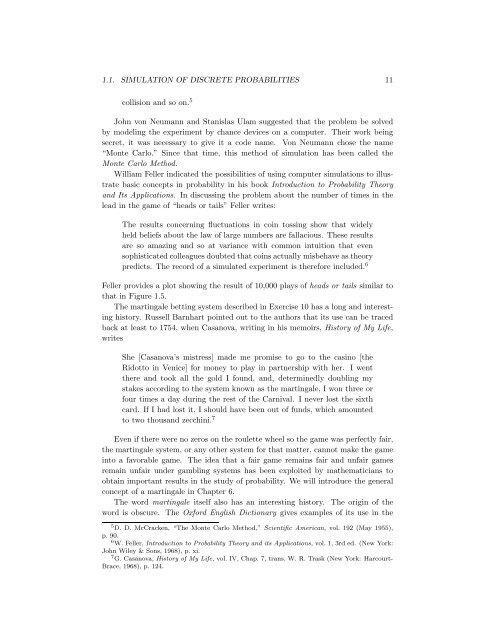Chapter 1 Discrete Probability Distributions - DIM
Chapter 1 Discrete Probability Distributions - DIM
Chapter 1 Discrete Probability Distributions - DIM
- No tags were found...
You also want an ePaper? Increase the reach of your titles
YUMPU automatically turns print PDFs into web optimized ePapers that Google loves.
1.1. SIMULATION OF DISCRETE PROBABILITIES 11collision and so on. 5John von Neumann and Stanislas Ulam suggested that the problem be solvedby modeling the experiment by chance devices on a computer. Their work beingsecret, it was necessary to give it a code name. Von Neumann chose the name“Monte Carlo.” Since that time, this method of simulation has been called theMonte Carlo Method.William Feller indicated the possibilities of using computer simulations to illustratebasic concepts in probability in his book Introduction to <strong>Probability</strong> Theoryand Its Applications. In discussing the problem about the number of times in thelead in the game of “heads or tails” Feller writes:The results concerning fluctuations in coin tossing show that widelyheld beliefs about the law of large numbers are fallacious. These resultsare so amazing and so at variance with common intuition that evensophisticated colleagues doubted that coins actually misbehave as theorypredicts. The record of a simulated experiment is therefore included. 6Feller provides a plot showing the result of 10,000 plays of heads or tails similar tothat in Figure 1.5.The martingale betting system described in Exercise 10 has a long and interestinghistory. Russell Barnhart pointed out to the authors that its use can be tracedback at least to 1754, when Casanova, writing in his memoirs, History of My Life,writesShe [Casanova’s mistress] made me promise to go to the casino [theRidotto in Venice] for money to play in partnership with her. I wentthere and took all the gold I found, and, determinedly doubling mystakes according to the system known as the martingale, I won three orfour times a day during the rest of the Carnival. I never lost the sixthcard. If I had lost it, I should have been out of funds, which amountedto two thousand zecchini. 7Even if there were no zeros on the roulette wheel so the game was perfectly fair,the martingale system, or any other system for that matter, cannot make the gameinto a favorable game. The idea that a fair game remains fair and unfair gamesremain unfair under gambling systems has been exploited by mathematicians toobtain important results in the study of probability. We will introduce the generalconcept of a martingale in <strong>Chapter</strong> 6.The word martingale itself also has an interesting history. The origin of theword is obscure. The Oxford English Dictionary gives examples of its use in the5 D. D. McCracken, “The Monte Carlo Method,” Scientific American, vol. 192 (May 1955),p. 90.6 W. Feller, Introduction to <strong>Probability</strong> Theory and its Applications, vol. 1, 3rd ed. (New York:John Wiley & Sons, 1968), p. xi.7 G. Casanova, History of My Life, vol. IV, Chap. 7, trans. W. R. Trask (New York: Harcourt-Brace, 1968), p. 124.
















